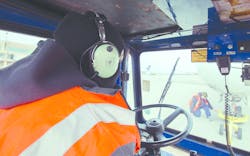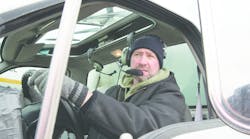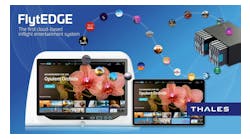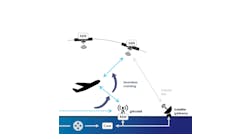When examining ramp operations, clear communication and safety go hand-in-hand. Additionally, wireless communications provide the same safety features while granting users more mobility during ramp and maintenance operations.
David Clark Company has been manufacturing headsets and systems for ground support operations for more than 30 years. Its systems are currently in use at hundreds of airports, globally.
David Clark’s latest communication system, the Series 9900 Wireless Communication System, was designed as an upgrade to the wired Series 3000 headsets for pushback and general ramp communications as well as the Series 3800 headsets for deicing operations.
“The primary benefit of the Series 9900 Wireless System over the original wired systems is the ability to provide all crew workers with hands-free, simultaneous comms between themselves, as well as PTT to the flight deck, adding more eyes and ears to the operation, and thereby greatly increasing ramp safety, decreasing accidents and incursions and enhancing efficiencies to ensure consistent on-time turnaround performance,” says Bob Daigle, systems product manager at David Clark.
With wireless communication equipment, ground crews are able to communicate clearly at normal voice levels, with the advantages of greater freedom and mobility during ramp and maintenance operations, without being tethered to GSE and other apparatus.
“It’s a dangerous area out there on the ramp with all these aircraft moving, and all the other vehicles that are moving around out there,” says Garry Marlin, analyst for ramp policy and procedures at American Airlines. “We want to keep our personnel as safe as possible and the David Clark Wireless System helps us work to accomplish that.”
David Clark offers a number of headset models within its Series 9900 system, offering over-the-head styles, single- and dual-ear configurations and mic-shield options. All these headsets feature dynamic earphones, noise-canceling microphones and various comfort features.
In addition to headsets, other major system components include belt stations that are worn by each crew member and a wireless gateway to link the users. Specific system components will vary depending on applications, such as pushback or deicing.
The Series 9900 Wireless System provides a range of 300 and 1,700 feet from the wireless gateway, depending on environment.
“This is more than enough range for aircraft pushback and towing operations, as well as maintenance and deicing operations,” Daigle explains. “David Clark belt stations provide audio prompts to the user’s headset should a user stray out of range, as well as voice prompts that audibly confirm connection status and a low battery warning.”
Removable Li-Polymer batteries power the system for up to 24 hours of continuous use. The company’s A99-14CRG charging unit can recharge up to four batteries simultaneously, providing a full charge in three to four hours.
Company officials say the most important factors when selecting a wireless communication system is durability of components, ease-of-use and reliability.
“The Series 9900 Wireless System features marine-grade, water-tight components to guard against water damage, and is virtually impervious to extreme temperatures,” Daigle says, noting comfort is a critical factor too.
“Communication performance is enhanced by the utilization of the latest DECT-based wireless technology, designed to operate exclusively for voice communication,” he adds. “Communication is clear while secure signaling prevents unwanted interception and/or cross talk from other work groups and systems.”
A quality communication system enhances situational awareness of the entire ground support team, enabling ground handlers to do their jobs efficiently.
“Speech is undeniably faster than using hand signals, and without a headset communication system, the shouts of ramp crews are drowned out by the din of roaring aircraft engines, wind and other ambient noise in the ramp environment,” Daigle says, adding during some pushbacks, a driver may not always have direct visual contact with wing walkers. “The ability for crews to communicate verbally at normal speech levels in such conditions is an extremely valuable asset.”
Beyond improved communications, David Clark officials note that the Series 9900 system headsets provide noise attenuation of up to 26 decibels.
“Hearing protection also helps to eliminate ‘noise fatigue,’ keeping crews more alert throughout the course of their shifts,” Daigle points out.
With more efficient ground operations, airlines benefit due to improved on-time performance.
“The system may also help save airlines hundreds of thousands in lost time, incident reporting and damages to aircraft, airport property and other equipment,” Daigle says.
“The question you have to ask is, ‘What are we spending on aircraft damages versus the cost of the system?’” adds Marlin. “There’s your savings.”
Overall David Clark officials say the Series 9900 Wireless Systems can help promote significant cost savings through increased aircraft availability, reduced maintenance man-hours, flight delays and inventory costs – all while providing a greater degree of operational readiness, situational awareness and safety.
For additional information regarding operation and maintenance configurations and system components for both pushback and deicing operations, visit www.AviationPros.com/12410793.






